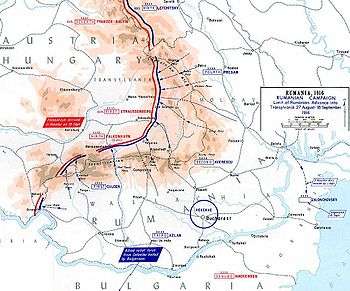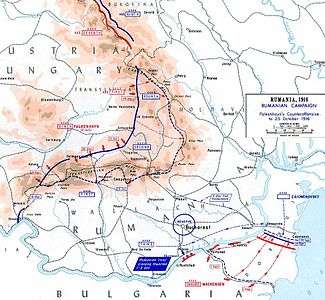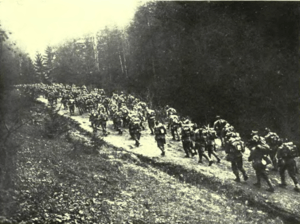Battle of Transylvania
| ||||||||||||||||||||||||||||||||||
The Battle of Transylvania was the first major operation of the Romanian forces Campaign during World War I, beginning on 27 August 1916. It started as an attempt by the Romanian Army to seize the disputed province of Transylvania, and potentially knock Austria-Hungary out of the war. Although initially successful, the offensive was brought to a halt after Bulgaria's attack on Dobruja. Coupled with a successful German and Austro-Hungarian counterattack after September 18, the Romanian Army was eventually forced to retreat back to the Carpathians by late October.
Background
Before the war, the Kingdom of Romania was an ally of Austria-Hungary; however, when war broke out in 1914 Romania pledged neutrality - claiming that Austria-Hungary had started the war and thus Romania had no obligation to join it. Romania eventually joined the Entente, on the condition that the Allies recognise Romanian authority over Transylvania; Romanians being the majority population in the region.[2] The Allies accepted the terms, and Romania declared war on Austria-Hungary on 27 August.
Battle
Romanian offensive (27 August – 18 September)

On the night of 27 August, three Romanian armies crossed the largely undefended Carpathian passes, meeting only sporadic resistance by Austro-Hungarian border units. The Romanian plan (Hypothesis Z) called for a rapid advance to the strategically important Mureş River with Budapest as the ultimate target.[3] The main advance was carried on by the Second Army, with the First and Fourth on its flanks. The second Army crossed the border on the night of 27–28 August and advanced into Transylvania.
In the first phase of the offensive (27 August-2 September), the Second Army conquered the Lepșa, Putna, Năruja and Zăbala Vallyes and advanced towards Covasna. Fierce fighting took place at Vama Buzăului, with the Romanians capturing the town, inflicting heavy losses on the opposing forces - totaling 132 dead and wounded, and another 492 prisoners. On 29 August the city of Brașov was captured, and on 31 August, the villages of Tohanul Nou and Tohanul Vechi were captured. On 2 September the first phase of the Romanian offensive was over, with the Second Army reaching the Cătălina-Zăbala-Dobârlau-Prejmer-Feldioara-Vlădeni line. To the north of the Second Army, the Fourth Army conquered the Tulgheș Pass and advanced westwards. To the west, the First Army crossed the border on its entire length and captured the city of Orșova before advancing towards the outskirts of Sibiu.
In the second phase of the offensive (3–10 September), the Second Army crossed the Olt river and captured Sfântu Gheorghe on 7 September. By the end of the second phase, the Second Army controlled all of the Brașov Depression, reaching the Cătălina-Arcuș-Vâlcele-Feldioara-Șercaia-Șinca Veche line.
In the third phase (11–18 September), the Second Army conquered Merești, forced the crossing of the Olt at Rupea, and obtained a foothold to conquer Dăișoara. Here the Romanian troops benefited from the support of local people, with a young woman from Pârâu village guiding a Romanian sub-unit behind enemy positions. On 19 September the Second Army was ordered to adopt a defensive posture on the ground captured and hold the Odorhei-Paloș-Fișer-Dăișoara-Ticușu Nou-Toarcla-Săsăuș-Romanu Nou-Cârtișoara-Avrig line.
During the 29 days of the operation, the Second Army averaged over 100 km (62 mi) distance of penetration of enemy lines.[4]
Central Powers Counter-offensive (26 September – 25 October)
Erich von Falkenhayn, recently fired as Chief of Staff, assumed command of the Ninth Army and began a counter-attack against the Romanians. On 18 September German forces struck the Romanian First Army near Haţeg, forcing them to stop their advance and switch to defence. Eight days later the elite Alpen Korps took the city of Sibiu, and on 17 October the Romanian Second Army was defeated at Braşov. The Fourth Army, despite little pressure from the enemy, retreated to the mountains. By 25 October the Romanian troops were routed and withdrew to their prewar positions, but managed to repulse German and Austro-Hungarian attempts to break through the Prahova Valley and into Bucharest via the shortest route, as the Germans had planned.
Aftermath
| ||||||||||||||||||||||||||||||||
After pushing the Romanian Army back to the Carpathians, the Germans began their conquest of Oltenia. They entered the region on 26 October and reached Târgu Jiu the next day, where their advance was halted by stiff Romanian resistance. The Romanians counter-attacked on the following day, pushing the Germans back towards the border. On 29 October the Germans regrouped, and on 1 November they launched a much more powerful attack. The Romanians could not repel the renewed German attack and, by the middle of November, Târgu Jiu was in their hands. They continued their advance, and on 21 November the regional capital Craiova was occupied. The last significant action of the battle was the Charge of Robănești on 23 November, one of the most daring actions by the Romanian Army. By 26 November all of Oltenia had been seized by the Germans, pushing the Romanian forces East of the Olt river. The next day they began their advance towards Bucharest, the Romanian capital.
The Hungarian Cultural Area
After the Romanian Army withdrew from Transylvania, in July 1917, the Hungarian Government created the "Hungarian Cultural Area", comprising the mainly Romanian inhabited Krassó-Szörény, Hunyad, Szeben, Fogaras and Brassó counties on the border with Romania. These counties welcomed the Romanian troops when they invaded, so they were united in this "cultural area" in order to prevent them from any exposure to "foreign influence".[5] By the end of the war, over 3,000 Romanian primary schools were closed.[6]
Battle maps
-

Romanian invasion of Austria-Hungary, August 1916
-

Central Powers counterattack, September–October 1916
Notes
- 1 2 "Romania's Attempted Occupation of Transylvania". Mek.niif.hu. Retrieved 2009-05-05.
- ↑ http://www.magtudin.org/HARASZTI_ENDRE_Ethnic_History_of_Transylvania.pdf
- ↑ Torrie, Glenn E. (Spring 1978). "Romania's Entry into the First World War: The Problem of Strategy" (PDF). Emporia State Research Studies. Emporia State University. 26 (4): 7–8.
- ↑ Romanian 2nd Army offensive in Transylvania http://www.worldwar2.ro/arme/?language=ro&article=114
- ↑ C. Stan, "Școala poporană din Făgăraș și de pe Târnave", Sibiu, 1928, p. 54.
- ↑ Stoica, Vasile (1919). The Roumanian Question: The Roumanians and their Lands. Pittsburgh: Pittsburgh Printing Company. p. 27.
References
- Keegan, John (2000) [1998]. "The Year of Battles". The First World War. Vintage Books. Missing or empty
|title=(help)
